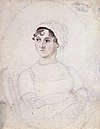Related Research Articles

Jane Austen was an English novelist known primarily for her six novels, which implicitly interpret, critique, and comment upon the British landed gentry at the end of the 18th century. Austen's plots often explore the dependence of women on marriage for the pursuit of favourable social standing and economic security. Her works are an implicit critique of the novels of sensibility of the second half of the 18th century and are part of the transition to 19th-century literary realism. Her deft use of social commentary, realism and biting irony have earned her acclaim among critics and scholars.
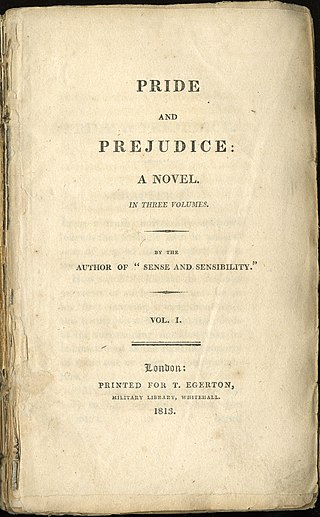
Pride and Prejudice is the second novel by English author Jane Austen, published in 1813. A novel of manners, it follows the character development of Elizabeth Bennet, the protagonist of the book, who learns about the repercussions of hasty judgments and comes to appreciate the difference between superficial goodness and actual goodness.

Sense and Sensibility is the first novel by the English author Jane Austen, published in 1811. It was published anonymously; By A Lady appears on the title page where the author's name might have been. It tells the story of the Dashwood sisters, Elinor and Marianne as they come of age. They have an older half-brother, John, and a younger sister, Margaret.

Emma is a novel written by English author Jane Austen. It is set in the fictional country village of Highbury and the surrounding estates of Hartfield, Randalls and Donwell Abbey, and involves the relationships among people from a small number of families. The novel was first published in December 1815, although the title page is dated 1816. As in her other novels, Austen explores the concerns and difficulties of genteel women living in Georgian–Regency England. Emma is a comedy of manners.

The Regency era of British history is commonly described as the years between c. 1795 and 1837, although the official regency for which it is named only spanned the years 1811 to 1820. King George III first suffered debilitating illness in the late 1780s, and relapsed into his final mental illness in 1810; by the Regency Act 1811, his eldest son George, Prince of Wales, was appointed prince regent to discharge royal functions. When George III died in 1820, the Prince Regent succeeded him as George IV. In terms of periodisation, the longer timespan is roughly the final third of the Georgian era (1714–1837), encompassing the last 25 years or so of George III's reign, including the official Regency, and the complete reigns of both George IV and his brother and successor William IV. It ends with the accession of Queen Victoria in June 1837 and is followed by the Victorian era (1837–1901).

Persuasion is the last novel completed by the English author Jane Austen. It was published on 20 December 1817, along with Northanger Abbey, six months after her death, although the title page is dated 1818.
Sanditon (1817) is an unfinished novel by the English writer Jane Austen. In January 1817, Austen began work on a new novel she called The Brothers, later titled Sanditon, and completed eleven chapters before stopping work in mid-March 1817, probably because of illness. R.W. Chapman first published a full transcription of the novel in 1925 under the name Fragment of a Novel.

Lady Susan is an epistolary novella by Jane Austen, possibly written in 1794 but not published until 1871. This early complete work, which the author never submitted for publication, describes the schemes of the title character.
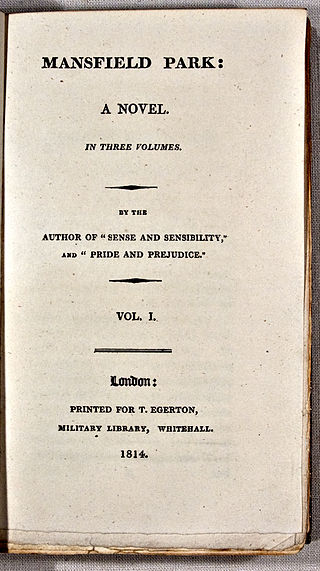
Mansfield Park is the third published novel by the English author Jane Austen, first published in 1814 by Thomas Egerton. A second edition was published in 1816 by John Murray, still within Austen's lifetime. The novel did not receive any public reviews until 1821.
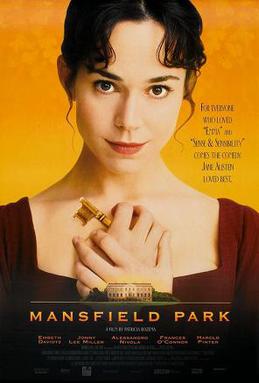
Mansfield Park is a 1999 British romantic comedy-drama film based on Jane Austen's 1814 novel of the same name, written and directed by Patricia Rozema. The film departs from the original novel in several respects. For example, the life of Jane Austen is incorporated into the film, as are the issues of slavery and West Indian plantations. The majority of the film was filmed on location at Kirby Hall in Northamptonshire.

The reception history of Jane Austen follows a path from modest fame to wild popularity. Jane Austen (1775–1817), the author of such works as Pride and Prejudice (1813) and Emma (1815), has become one of the best-known and most widely read novelists in the English language. Her novels are the subject of intense scholarly study and the centre of a diverse fan culture.

Miss Austen Regrets is a 2007 biographical drama television film directed by Jeremy Lovering and written by Gwyneth Hughes. It stars Olivia Williams as Jane Austen, with Imogen Poots, Greta Scacchi, Hugh Bonneville, Adrian Edmondson and Jack Huston. It premiered on 21 August 2007 on BBC 1 in the United Kingdom and on 3 February 2008 in the United States by PBS' drama anthology television series Masterpiece as part of The Complete Jane Austen, the US version of The Jane Austen Season.

Anne Elliot is the protagonist of Jane Austen's sixth and last completed novel, Persuasion (1817).
Henry Crawford is one of the main characters in Jane Austen's 1814 novel, Mansfield Park. He is depicted as a man who, though not conventionally handsome, has great charisma. He is lively, witty and charming, a great asset at dinner parties, and admired by nearly all. Henry and his sister bring a fresh energy to the rather dour and oppressive atmosphere of Mansfield Park. At Sotherton his potential for disruption begins to emerge.

Edmund Bertram is a lead character in Jane Austen's 1814 novel Mansfield Park. He is Sir Thomas's second son and plans to be ordained as a clergyman. He falls in love with Mary Crawford who constantly challenges his vocation. Edmund goes ahead with ordination. At the end of the novel he marries Fanny Price.
Jane Austen's (1775–1817) distinctive literary style relies on a combination of parody, burlesque, irony, free indirect speech and a degree of realism. She uses parody and burlesque for comic effect and to critique the portrayal of women in 18th-century sentimental and Gothic novels. Austen extends her critique by highlighting social hypocrisy through irony; she often creates an ironic tone through free indirect speech in which the thoughts and words of the characters mix with the voice of the narrator. The degree to which critics believe Austen's characters have psychological depth informs their views regarding her realism. While some scholars argue that Austen falls into a tradition of realism because of her finely executed portrayal of individual characters and her emphasis on "the everyday", others contend that her characters lack a depth of feeling compared with earlier works, and that this, combined with Austen's polemical tone, places her outside the realist tradition.
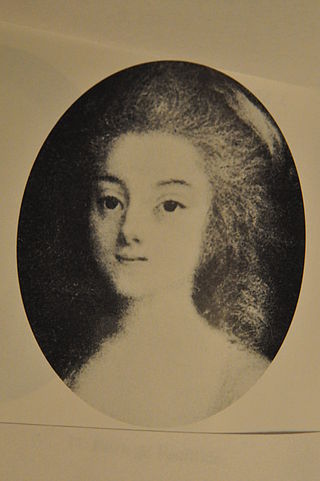
Eliza Capot, Comtesse de Feuillide was the cousin, and later sister-in-law, of novelist Jane Austen. She is believed to have been the inspiration for a number of Austen's works, such as Love and Freindship, Henry and Eliza, and Lady Susan. She may have also been the model from whom the character of Mary Crawford from the novel Mansfield Park is derived.

Sarah Harriet Burney was an English novelist. She was the daughter of the musicologist and composer Charles Burney and half-sister of the novelist and diarist Frances Burney. She had some intermittent success with her novels.

Oakley Hall is a Georgian manor in Oakley, Hampshire, located 10 km (6.2 mi) to the west of Basingstoke. Completed in 1795 by Wither Bramston, the building is now a hotel and conference centre. It is located in a wooded park intersected by the former South Western railway.

James Stanier Clarke (1766–1834) was an English cleric, naval author and man of letters. He became librarian in 1799 to George, Prince of Wales.
References
- Irene Collins (2002). Jane Austen and the Clergy. Hambledon Press. ISBN 1-85285-114-7.
